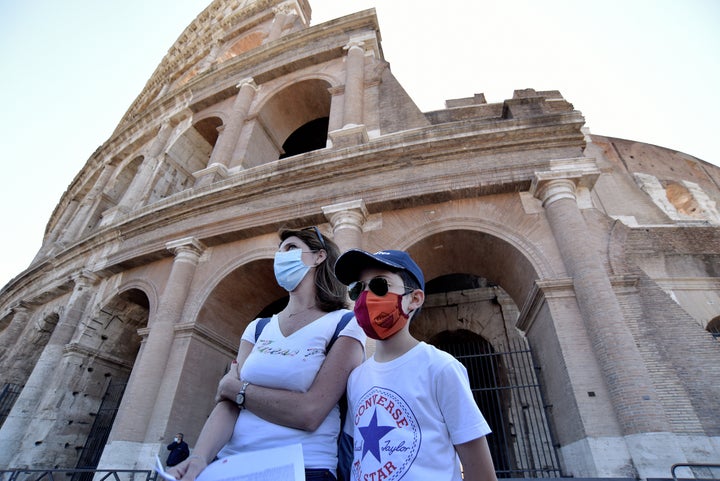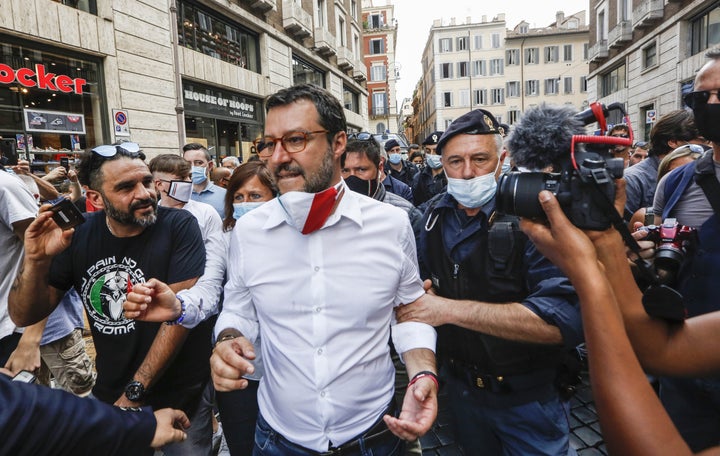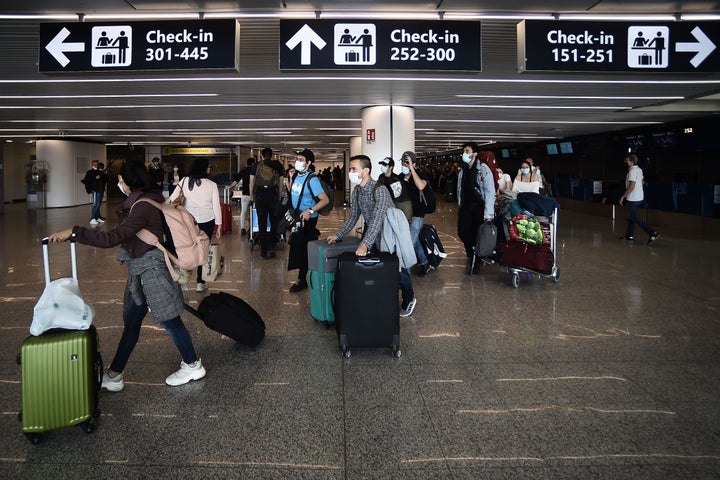Three months ago, as Italy became the world epicenter of the coronavirus pandemic, government officials took increasingly drastic measures to try to contain the virus’s spread — isolating towns, cordoning off regions and finally imposing a strict nationwide lockdown that kept 60 million people largely confined to their homes.
Now, however, Italy on Wednesday is lifting its travel restrictions, allowing residents to move freely between regions and inviting travelers from much of Europe to visit without needing to quarantine.
It is a major milestone for a country that has served as a harbinger of the pandemic’s deadly toll and the draconian lockdowns were to follow around the world, but now hopes to signal that life can return to some semblance of normalcy.
“I’m coming home after three months. I could not wait,” a young woman at Milan’s central train station told HuffPost Italy on Wednesday morning.
As of Tuesday, the total death toll in Italy stood at 33,530, according to the Civil Protection Agency, the third highest in the world after the United States and Britain.
The number of new coronavirus cases and deaths has been falling, however. Tuesday’s death toll was 55, down from 60 on Monday.
Other European nations are similarly loosening restrictions. Germany is also beginning to invite international travelers once again. In France, residents can now move freely throughout much of the country, while cafes in Paris are once again able to serve customers at outdoor tables. In the United Kingdom, the government is allowing people to get together in larger groups, and is planning to allow nonessential businesses to reopen on June 15.
Italy’s turnaround has been particularly dramatic, however. At the virus’s peak in late March, Italy recorded 919 deaths in a single day, a global record at the time. The world was shocked as military vehicles were filmed in the streets of northern Italy, brought in to move dozens of bodies from the city of Bergamo after the local crematorium struggled to keep up.

Still, the road to economic recovery will be difficult, and the threat of a second wave of coronavirus infections remains.
“Everyone must do their part, as it has always been in the most difficult moments in our history,” Italian Prime Minister Giuseppe Conte said on Tuesday, a public holiday. “Italy, our community, is our strength.”
Sergio Mattarella, Italy’s president, echoed Conte’s appeal for unity, while warning that the threat from the coronavirus persists.
“The revamp won’t be fast,” Mattarella said. “We need courage and caution.”
His comments came after Alberto Zangrillo, the head of intensive care at Italy’s San Raffaele Hospital in Lombardy, which bore the brunt of Italy’s COVID-19 epidemic, told state television on Sunday that the coronavirus is losing its strength and “clinically no longer exists.”
On Tuesday, as well, Italian opposition parties and hundreds of supporters defied social distancing rules to pack Rome’s central streets in an anti-government protest rally.
Matteo Salvini, the leader of the right-wing Northern League, took selfies with supporters and spoke to reporters wearing an Italian flag-colored face mask under his chin, images showed.
“I’ve got a mask, but experts say that the virus is dying,” Salvini said.

Scientists in Italy and around the world have strongly criticized the suggestion that the coronavirus is weakening, however.
“The virus is still circulating and has the high potential to spread, so we must not let our guard down,” Fabrizio Pregliasco, a virologist at the University of Milan, told HuffPost Italy.
The World Health Organization said this week that there is no evidence that the coronavirus is changing significantly, either in its form of transmission or in the severity of the disease it causes.
In an interview on Italian television, Anthony Fauci, the director of the U.S. National Institute for Allergy and Infectious Diseases, similarly dismissed the idea that the coronavirus was somehow weakening.
“I don’t think there’s any good evidence to say that the virus is losing any strength at all,” Fauci said. “Obviously viruses mutate as they replicate ... but if you look right now at the disease burden that we’re seeing in different cities in the United States, we are not seeing any indication that the disease is less severe.”

As travel restrictions were lifted on Wednesday, traffic congestion returned to highways around the country, and long lines for ferries began forming in the port city of Messina, in Sicily, as early as 4 a.m.
At Rome’s Fiumicino airport, thermal scanners have been installed to check the temperatures of passengers and airline staff, along with other new safety measures.
“A wide safety mechanism has been adopted in air transport for months now, and it has been gradually strengthened with the measures imposed by the authorities,” Ivan Bassato, executive vice president of operations at Aeroporti di Roma, told Reuters.
“In this way, people should not be afraid or worried of taking a plane, because they will not be exposed to a higher risk than the one they could find in public places.”
On Wednesday morning, however, the number of travelers at Fiumicino remained relatively light, and it may be some time before foreign tourists feel comfortable visiting.
Indeed, Dario Franceschini, Italy’s minister of culture and tourism, told USA Today this week that tourists are unlikely to return in force before next year, and the tourism economy — which accounts for 13% of Italy’s GDP — might not fully recover until 2023.
For now, Italians are enjoying visiting popular sites like the Colosseum and the Vatican without the crush of foreign tourists.
“We have put so much effort into reopening, so that we could be ready to welcome people and ensure safety, for visitors and staff,” Alfonsina Russo, the director of the Colosseum Archaeological Park, told The Guardian.
“Today is an important day … we’re reopening a symbol of Rome and Italy. But it is also a symbol of hope.”
With reporting from HuffPost Italy and Reuters.
- Stay up to date with our live blog as we cover the COVID-19 pandemic
- 7 essential pieces of relationship advice for couples in quarantine
- What you need to know about face masks right now
- How to tell if you need to start doing online therapy
- Lost your job due to coronavirus? Here’s what you need to know.
- Parenting during the coronavirus crisis?
- The HuffPost guide to working from home
- What coronavirus questions are on your mind right now? We want to help you find answers.
- Everyone deserves accurate information about COVID-19. Support journalism without a paywall — and keep it free for everyone — by becoming a HuffPost member today.